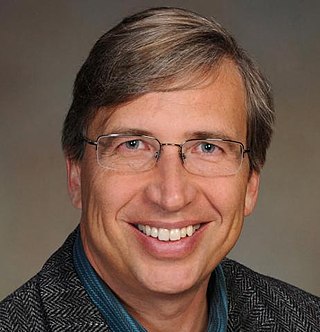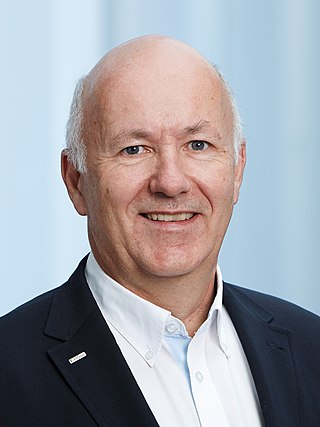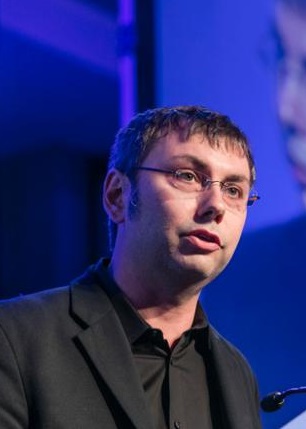Related Research Articles

Simultaneous localization and mapping (SLAM) is the computational problem of constructing or updating a map of an unknown environment while simultaneously keeping track of an agent's location within it. While this initially appears to be a chicken or the egg problem, there are several algorithms known to solve it in, at least approximately, tractable time for certain environments. Popular approximate solution methods include the particle filter, extended Kalman filter, covariance intersection, and GraphSLAM. SLAM algorithms are based on concepts in computational geometry and computer vision, and are used in robot navigation, robotic mapping and odometry for virtual reality or augmented reality.

Swarm robotics is an approach to the coordination of multiple robots as a system which consist of large numbers of mostly simple physical robots. ″In a robot swarm, the collective behavior of the robots results from local interactions between the robots and between the robots and the environment in which they act.″ It is supposed that a desired collective behavior emerges from the interactions between the robots and interactions of robots with the environment. This approach emerged on the field of artificial swarm intelligence, as well as the biological studies of insects, ants and other fields in nature, where swarm behaviour occurs.

Gregory L. Dudek is a Canadian computer scientist specializing in robotics, computer vision, and intelligent systems. He is a chaired professor at McGill University where he has led the Mobile Robotics Lab since the 1990s. He was formerly the director of McGill's school of computer science and before that director of McGill's center for intelligent machines.

A mobile robot is an automatic machine that is capable of locomotion. Mobile robotics is usually considered to be a subfield of robotics and information engineering.
Hugh Francis Durrant-Whyte is a British-Australian engineer and academic. He is known for his pioneering work on probabilistic methods for robotics. The algorithms developed in his group since the early 1990s permit autonomous vehicles to deal with uncertainty and to localize themselves despite noisy sensor readings using simultaneous localization and mapping (SLAM).
Robotics is the branch of technology that deals with the design, construction, operation, structural disposition, manufacture and application of robots. Robotics is related to the sciences of electronics, engineering, mechanics, and software. The word "robot" was introduced to the public by Czech writer Karel Čapek in his play R.U.R., published in 1920. The term "robotics" was coined by Isaac Asimov in his 1941 science fiction short-story "Liar!"

The Deep Phreatic Thermal Explorer (DEPTHX) is an autonomous underwater vehicle designed and built by Stone Aerospace, an aerospace engineering firm based in Austin, Texas. It was designed to autonomously explore and map underwater sinkholes in northern Mexico, as well as collect water and wall core samples. This could be achieved via an autonomous form of navigation known as A-Navigation. The DEPTHX vehicle was the first of three vehicles to be built by Stone Aerospace which were funded by NASA with the goal of developing technology that can explore the oceans of Jupiter's moon Europa to look for extraterrestrial life.

Legged robots are a type of mobile robot which use articulated limbs, such as leg mechanisms, to provide locomotion. They are more versatile than wheeled robots and can traverse many different terrains, though these advantages require increased complexity and power consumption. Legged robots often imitate legged animals, such as humans or insects, in an example of biomimicry.

Wolfram Burgard is a German roboticist. He is a full professor at the Albert-Ludwigs-Universität Freiburg where he heads the Laboratory for Autonomous Intelligent Systems. He is known for his substantial contributions to the simultaneous localization and mapping (SLAM) problem as well as diverse other contributions to robotics.

Robot localization denotes the robot's ability to establish its own position and orientation within the frame of reference. Path planning is effectively an extension of localisation, in that it requires the determination of the robot's current position and a position of a goal location, both within the same frame of reference or coordinates. Map building can be in the shape of a metric map or any notation describing locations in the robot frame of reference.
The Guidance, Control and Decision Systems Laboratory (GCDSL) is situated in the Department of Aerospace Engineering at the Indian Institute of Science in Bangalore, India. The Mobile Robotics Laboratory (MRL) is its experimental division. They are headed by Dr. Debasish Ghose, Full Professor.
Ant robotics is a special case of swarm robotics. Swarm robots are simple robots with limited sensing and computational capabilities. This makes it feasible to deploy teams of swarm robots and take advantage of the resulting fault tolerance and parallelism. Swarm robots cannot use conventional planning methods due to their limited sensing and computational capabilities. Thus, their behavior is often driven by local interactions. Ant robots are swarm robots that can communicate via markings, similar to ants that lay and follow pheromone trails. Some ant robots use long-lasting trails. Others use short-lasting trails including heat and alcohol. Others even use virtual trails.
Naomi Ehrich Leonard is the Edwin S. Wilsey Professor of Mechanical and Aerospace Engineering at Princeton University. She is the director of the Princeton Council on Science and Technology and an associated faculty member in the Program in Applied & Computational Mathematics, Princeton Neuroscience Institute, and the Program in Quantitative and Computational Biology. She is the founding editor of the Annual Review of Control, Robotics, and Autonomous Systems.

Roland Siegwart, is director of the Autonomous Systems Lab (ASL) in Switzerland, of the Institute of Robotics and Intelligent Systems at ETH Zurich and a known robotics expert.
Stefano Soatto is professor of computer science at the University of California, Los Angeles (UCLA), in Los Angeles, CA, where he is also professor of electrical engineering and founding director of the UCLA Vision Lab.
Paul Newman is a British engineer and academic, the BP Professor of Information Engineering at the University of Oxford, and a Fellow of Keble College, Oxford. He is head of the Oxford Mobile Robotics Group (MRG) and CTO at Oxbotica.

Silvia Ferrari is an American aerospace engineer. She is John Brancaccio Professor at the Sibley School of Mechanical and Aerospace Engineering at Cornell University and also the director of the Laboratory for Intelligent Systems and Control (LISC) at the same university.

Margarita Chli is an assistant professor and leader of the Vision for Robotics Lab at ETH Zürich in Switzerland. Chli is a leader in the field of computer vision and robotics and was on the team of researchers to develop the first fully autonomous helicopter with onboard localization and mapping. Chli is also the Vice Director of the Institute of Robotics and Intelligent Systems and an Honorary Fellow of the University of Edinburgh in the United Kingdom. Her research currently focuses on developing visual perception and intelligence in flying autonomous robotic systems.

Ryan M. Eustice is an American roboticist, and the Senior Vice President of Human-centric AI and Technology Adoption at the Toyota Research Institute (TRI). He is also a Professor of Robotics and Naval Architecture & Marine Engineering at the University of Michigan.
References
I do not expect there to be taxis in Manhattan with no drivers in my lifetime.
— Leonard in 2013 [5]
- 1 2 3 4 "Curriculum Vitae" (PDF). mit.edu. Archived from the original (PDF) on 2013-09-24. Retrieved 2015-07-02.
- ↑ Leonard, J.J.; Durrant-whyte, H.F. (1992). Directed Sonar Sensing for Mobile Robot Navigation. Springer.
- ↑ Leonard, J.J.; Durrant-whyte, H.F.; Cox, I.J. (1992). "Dynamic Map Building for an Autonomous Mobile Robot". The International Journal of Robotics Research. 11 (4): 286. doi:10.1177/027836499201100402. S2CID 120016766 . Retrieved 2008-07-09.
- ↑ "Archived copy". Archived from the original on 2008-06-01. Retrieved 2008-07-09.
{{cite web}}: CS1 maint: archived copy as title (link) - ↑ "Driverless Cars Are Further Away Than You Think". MIT Technology Review. October 22, 2013. Retrieved 2015-07-02.